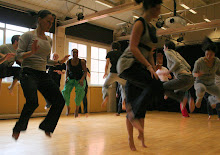Question.1
‘The term [Physical Theatre] has been collectively used to identify an eclectic production commonly understood to be on which focuses on the unfolding of a narrative through physicalized events and which relegates verbal narrative.’ (Sanchez-Colberg in Keefe & Murray; 2007. p.g. 21) To both further and elaborate on this quote; physical theatre does allow the unfolding of narrative through physical movements, however, it also allows the unfolding of characters and identities through the physicality of the genre. With the genre being so clearly being a physical one, the genre allows a greater exploration of character development & self discovery of the performers than could possibly be seen through ‘straight theatre’; as the ‘physical theatre’ genre ‘the emphasis is on the actor-as-creator rather than the actor-as-interpreter; the working process is collaborative; the working practice is somantic & the stage stage-spectator relationship is open’ (Callery; 2001. p.g.5) This quote, explains how the relationship with the audience is also a great influence to the genre; therefore, the genre isn’t just about the physicality of the performers on the stage, its also how the audience influence that movement and interpret the physicalized events that are occurring in the performance space.
Question.2
‘The term itself – ‘physical theatre’ – denotes a hybrid character (Sanchez-Colberg in Keefe & Murray; 2007. p.g. 21). The idea of the ‘physical theatre’ genre being a hybrid comes from the idea that the genre can not defined in either the ‘dance world’ or the ‘drama world’, it falls as a combination of both ‘worlds’. ‘It is precisely this double current of influences which needs to be taken into consideration […] of the new genre’ (Sanchez-Colberg in Keefe & Murray; 2007. p.g. 21). This quote is a direct on look to the work that goes into the ‘hybrid genre’. As the performance can begin from a stimulus and a performers attitudes towards this stimuli; this being a tool usually used in the ‘drama world’, however the performance can also use movement to music to a syncopated rhythm both to the music and against it this defiantly coming from the ‘dance world’.
Question.3
A British performance company whose practice falls in to the remit of ‘physical theatre’ from the definitions above is ‘DV8 Physical Theatre Company’. ‘DV8 Physical Theatre's work is about taking risks, aesthetically and physically, about breaking down the barriers between dance [and] theatre’. This quote from there website both reinforces the idea and shows how the company admit to ‘physical theatre’ being a ‘hybrid genre’. As well as the company working in ‘hybrid genre’, they also admit, on their website, to the genre being a performance where the performance work is lead via its performers and their relationships, ‘DV8 is motivated by artistic inspiration and creative need’. DV8 physical theatre company work ‘relies on pushing its own boundaries and on the constant re-examination of the roles and relationships of men and women in our society’, therefore its performance work is an exploration into social politics shown through physical work rather than text based work.
Bibliography
Callery, D (2001) Through The Body: New York: Routledge
DV8 Physical Theatre (2008) [Home page] [online] [February 22, 2009.]
< www.dv8.co.uk/about.dv8/artistic.policy.html >
Keefe, J & S Murray (2007) Physical Theatres: A Critical Reader London: Routledge
Edward Critchlow
skip to main |
skip to sidebar
Welcome to Porto2009.
This is the begining of our journey on the road of Porto2009. And the blog will give us the opportunity as a group to reflect on the work in which we have done within the sessions. We will keep you posted regarding the process we are making along the way.....
Enjoy.
Enjoy.



No comments:
Post a Comment